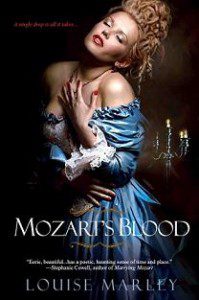

Mozart's Blood by Louise Marley
Vampires for grownups. Remember when that’s how it used to be? Well, rejoice, because there’s a new vampire in town, and there’s not an angsty teenager in sight.
Louise Marley’s Mozart’s Blood invokes comparisons to Dracula and Interview with a Vampire because of the sweep and sophistication of her story. She mixes music, opera, and history with a deft hand, and weaves in a story of love and loss, the ache of immortality, and tyranny of greed and lust.
The world of opera in the modern day and throughout the centuries at the world’s great opera houses comes vividly to life, and that’s because Marley, a former opera singer, knows her setting, since she lived it. And she deftly weaves the facts — about Teresa Saporiti, the young soprano who created the Dona Anna role for the first performance of Don Giovanni, about Mozart and his life and death, about La Scala (which is almost a character in the book) — with her made up world, in which Saporiti never died and maintains a bond with Mozart that brings her both grief and joy.
Take a Virtual Tour of Mozart’s Blood
Marley doesn’t shy away from the hard questions. How does a person who believes in God and who takes comfort in God survive as a vampire, knowing they are no longer in God’s grace? In fact, grace is a subtle theme throughout the book.
How does a person live knowing they have become a monster? One of the characters has the strength to essentially will himself to death; another, to make compromises that allow her to survive, but always with the sorrow of her choices.
Is redemption possible? Or is music enough? I don’t know if the last bit is made explicit, but I was thinking about it while I read.


0 Comments